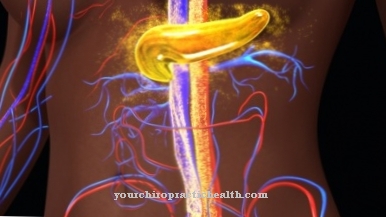The Stocking skin sign is a movement of the toes when the knee joint is bent against resistance. This movement is physiological in children under one year of age. In adults, however, it is assessed as a pyramidal sign and indicates damage to the central motor neurons.
What is the Strümpell sign?

The Strümpell sign is an extension of the big toe towards the foot. A flexion in the knee joint triggers the dorsiflexion of the toe against resistance. The extension of the big toe towards the back of the foot is achieved by the extensor hallucis longus muscle. Toes II to V often extend at the same time as the dorsiflexion of the big toe.
The Strümpell sign is physiological in small children under one year of age. The movement in adults is pathological and is assessed as a pyramidal orbit sign. Together with the reflexes based on Babinski, Gordon, Oppenheim and Chaddock, the Strümpell sign is often included in the Babinski group.
Signs of the pyramidal tracts indicate neurological damage to the pyramidal tracts that connect the first and second motor neurons in the spinal cord. As part of the pyramidal system, the pyramidal tracts are involved in all voluntary and reflex motor skills.
The Strümpell symbol is named after Adolf von Strümpell, who first described it. The German internist first documented the movement at the end of the 19th century. The toe movement is based on its name too Stocking reflex or Strümpel's sign called. In the narrower sense, the Strümpell sign is not a reflex, but a movement.
Function & task
In small children under one year of age, the neurological interconnection of the individual muscle groups is not yet differentiated. Therefore, they still move many muscle groups together, which can later be moved individually. In the Strümpell sign, there is such a joint movement with the dorsiflexion of the big toe and the simultaneous spreading of the remaining toes. Sometimes the foot is also supinated.
In the first few years of life, the central motor neurons slowly take on their function as higher-level control and switching centers for motor skills. As a result, the individual muscles no longer move in groups with the nearest muscles, but can be moved individually. The reflex movements also decrease after the first year of life, which is also related to the greater control by the central motor neurons. The Strümpell sign usually disappears after the first year of life and can therefore no longer be triggered in adulthood.
If it can be triggered, the control by the central motor neurons is likely weakened or lost. In adults, the Strümpell sign therefore corresponds to an obligatory pathological movement of the toes when the knee joint is bent.
Strong pressure is applied to the knee and the patient tries to flex the knee in the knee joint. The dorsal movement of the big toe is an extension according to its name, but belongs to the flexion synergy, so that the knee flexion against resistance can trigger the dorsiflexion of the toes.
The realizing extensor hallucis longus muscle is an extensor muscle of the lower leg muscles, the original surfaces of which correspond to the facies anterior and the membrana interossea cruris. The tendon of the muscle runs under the retinaculum musculorum extensorum superius towards the forefoot. At the transition to the dorsum of the foot, the tendon crosses the medial side of the anterior tibial artery and attaches to the dorsal surface of the big toe. The muscle is innervated via the deep fibular nerve and is attached to the L4 to S1 nerve tracts.
Illnesses & ailments
The Strümpell sign is relevant for neurological diagnostics. If the movement of the toes can be triggered, the symptoms are likely to be motor neuronal damage in the central nervous system. However, the Strümpell sign alone is by no means a reliable diagnostic tool for such damage, as it can sometimes also be triggered in healthy adults.
The mere dorsal movement of the big toe is usually not assessed as a characteristic sign of the pyramidal trajectory and is therefore of little diagnostic relevance. The sign of a pyramidal trajectory is only used if the remaining toes spread apart at the same time as the dorsal movement and, if necessary, supination also occurs. Further examinations are necessary to strengthen the suspicion of pyramidal or motor neuronal damage.
After a positive Strümpell sign, the patient is checked for further reflexes of the Babinski group, for example. Evidence of the Babinski reflex, the Chaddock sign, the Gordon sign and the Oppenheim sign can be helpful, for example. Damage to the central motor neurons is only likely if there are several pyramidal signs.
Such damage can be accompanied by spastic or flaccid paralysis and can be detected with an MRI of the skull and spine when contrast agent is administered. The MRI can also be used to identify which motor neuron is affected by a lesion.
Motor neuronal damage can be caused by neurological diseases such as ALS or MS. In MS, the patient's immune system attacks central nervous tissue. In ALS, on the other hand, there is degeneration of the motor nervous system, with damage to the central motor neurons being particularly characteristic.
A cerebral infarction (stroke) caused by a vascular occlusion in the middle cerebral artery can also damage the upper motor neuron. In addition to the damage caused by the disease, the lower motor neuron can under certain circumstances experience traumatic damage or be affected by a spinal cord infarction.



























